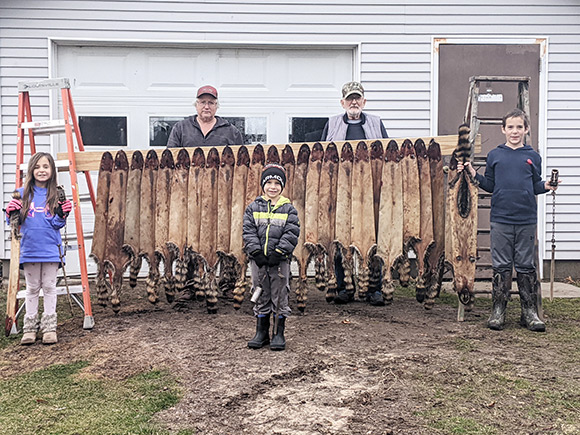 Team Fur News - Mar24
Team Fur News - Mar24
Lunch Money
By FUR-FISH-GAME Editor, John D. Taylor
.jpg)
A chipmunk. Not THE chipmonk. Photo:Annegret Kammer/Unsplash
“The Pines” was a stand of row-planted white pine trees, maybe 200 yards long and 75 yards wide. A green, cool and somewhat mysterious place, it lived down over the hill from my childhood home in Pennsylvania.
In the middle of The Pines, separating it into two segments, was a vernal wetland. Long phragmite reeds grew in this wetland. Who planted the trees, the reeds, or why they did this, I never learned. But it was one of the first special places I came to love, because it was my imagination’s home, a place where a kid could explore, experience and simply play to his heart’s content.
For example, a favorite early game of mine involved breaking off some of those tall reeds, at which point they magically became spears. I was either Achilles, the Greek warrior, chucking my spears at those darn Trojan enemies, or a 1960s television-style Indian, chucking my “Injun” spears at the few kids then in the neighborhood who played along. We had some pretty cool spear battles down there.
At the time, the suburban development in which my folks had bought their home was just beginning to expand. Our house was one of a row of eight houses along paved Blymire Road. But this quickly expanded, more houses erupting from the dirt mounds behind this first row. Soon another street was cut below that, adding two layers of additional homes.
By the time I was in Middle School, a third street was being cut – right into my treasured Pines. I remember going down over the hill to play in The Pines one day and encountering a big, ugly yellow bulldozer on a freshly dug road heading right into The Pines. It made me angry. And for a class project, I wrote a poem about it that was published in a local newspaper’s kids’ column.
The Pines were bulldozed in the name of “progress,” and my attention was soon diverted to the oak-laden woodlot next door to where The Pines had once stood.
Back then (mid-1970s) a 14-year kid roaming around with a BB gun wasn’t a big deal. Today, people would likely have a hissy fit, send the kid to a shrink and probably to a juvenile facility. And before the new row of houses was built, and the people who bought them moved in, I followed the dirt road that would become paved with houses north and south, to the edge of that woodlot.
A chipmunnk sat on a big hunk of quartz boulder that had been dug out of the ground by the bulldozer that destroyed The Pines.
Chipmunks were fair game. My BB gun adventures were limited by my "game warden" parents to starlings, grackles, and chipmunks. I treasured that BB gun – a Daisy “Spittin’ Image,” Model 1894 Winchester BB gun, spring-fired, nothing like the modern pump-up models. I’d scratched drawings of wildlife on the action and installed a rawhide sling. Cool stuff for a kid. Very cool.
While the chipmunk sat on that boulder eating an acorn, I took careful aim, and “pooiiinged” a spring-propelled copper BB his way. It hit the chipmunk, but apparently did no damage. The little rascal scurried up the base of a big oak tree on the edge of the woodlot. I cocked the lever and fired again. And again, and again, and again. All hits, I was sure.
Remember I was young and had yet to learn the sage advice of always bringing enough gun.
The chipmunk climbed up into the oak and peeked out over the Y formed by the tree’s trunk and a big branch.
“Poooiinng” said my BB gun, again and again and again. I could hear the BBs bounce off the chipmunk’s acorn-stuffed cheeks.
Finally, after 22 total shots – yeah, I counted 'em – the chimpmunk fell, probably more from exhaustion than any damage the spring-loaded BB gun had done.
I proudly picked up my prize and decided to take it home, skin it out and make a pouch out of the hide.
And I did just that.
Chipmunk skinning is a tedious chore, especially with a dull pocketknife. I didn’t have the patience to properly sharpen the blades. I tacked the hide (no tail) out on a spare piece of lumber and waited a couple of days until it dried. Then I sewed the sides of the hide together and I had my pouch.
What to put into it? Hmmmmm... Lunch money. That’d impress the girls. I was certain of it.
Standing in the school lunch line a week later, I proudly whipped out my chipmunk lunch-money pouch.
A girl — a pretty classmate carrying her lunch tray — walked past, quickly glanced down at the pouch, and recoiled in horror. The look on her face was clear: I was an awful human being, not worthy of breathing the Middle-School-cafeteria air. She whispered to her equally-pretty friend behind her, and that girl, too, shared the same horrified expression.
Then a voice two kids behind me said, “Hey, what’s that?”
It was Cindy Baugher. She’d caught a glimpse of my lunch-money pouch.
Expecting more disgust, I said, “Oh, it’s just something I made.”
“Can I see it?” Cindy asked.
My face lit up. I proudly handed her my chipmunk-hide lunch-money pouch.
“That’s pretty cool,” she said, as the line moved forward and she returned the pouch to my hand.
And just like that Cindy and I became friends.
I probably should have asked her out, but during the next five years in school I remained in the friend zone. Who knows? We might have been really good together. I wondered that upon seeing her at our 25-year class reunion. But that was one road of many not taken.
When the houses got built where the pines used to be, and the new people moved into them, one of those homeowners turned out to be a rabid anti-hunter. Her daughter was in my sister’s grade.
One day, as I carried my traps up to the Boy Scout woods — a Scout troop that I belonged to held meetings there in the summer — the woman evidently saw me and became enraged. It was a quarter-mile up over the far hill from her home, but that didn't matter. It also didn't matter that I had permission to trap the property.
A neighbor kid of hers, someone I thought was a friend, told her I'd shot at her picture window with my BB gun – a pane was scored with a BB hole in it – she called the cops on me.
I NEVER did that. The other kid, a more likely culprit, had lied about it. But one day, while checking my traps, a township police officer walked back into the woods, found me and took my BB gun away from me. He politely escorted me, packbasket and all, back home in his car to face my parents, who believed the anti-hunter.
Years later, I wondered if the cops still had my BB gun, but decided to let it go. Being unjustly accused by a crazy anti-hunter, and having my gun taken from me, only enhanced my passion for defending trapping, hunting and firearms, something that earned me the school nickname “Trapper John.” I gave speeches in class arguing these things were good conservation management tools.
So, my joyful early days as an outdoorsman around my childhood home slowly and steadily turned into disappointment. It was as if land development and "progress" existed solely to stop me from enjoying my outdoor pursuits. But at least it lit the fire that turned me into an ardent defender of our rights.
Even considering how it all ended, I’ll always smile remembering Cindy Baugher’s reaction to my lunch-money pouch. Maybe I'll bring it to our next reunion. It's gotta be around here somewhere.
Learn to improve quail habitat March 7-8
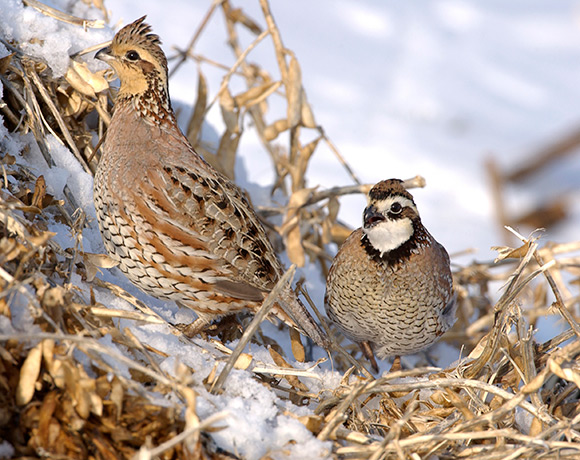
Male and female bobwhite quail. Photo: Missouri State Archives
The South Carolina Department of Natural Resources (SCDNR) will host its annual Wild Quail Management Seminar March 7-8 at the James W. Webb Wildlife Center and Management Area in Hampton County. Field demonstrations and classroom instruction will focus on habitat practices including firebreak establishment, prescribed burning, forest management, brush control, discing for native foods and supplemental food patch plantings. Presentations will be given on wild quail natural history, biology, predation and other factors that may be contributing to the population decline. An update on current research will also be presented. Speakers will include wildlife and forestry professionals from state and federal agencies. Bobwhite quail populations in the Southeast, including South Carolina, have been declining steadily over the past 60 years due to major land use change and reduction in suitable habitat. The annual Wild Quail Management Seminar is designed to instruct landowners and land managers in the proper techniques of creating habitat that will support native populations of bobwhite quail. The registration fee is $95 per person and includes meals, overnight accommodations and seminar materials. Registration is limited to 30 participants. For more information, contact the SCDNR Small Game Program in Columbia at (803) 734-3609, e-mail Patty Castine at CastineP@dnr.sc.gov or visit https://www.dnr.sc.gov/education/quail.html.
Iowa Frog and Toad Survey
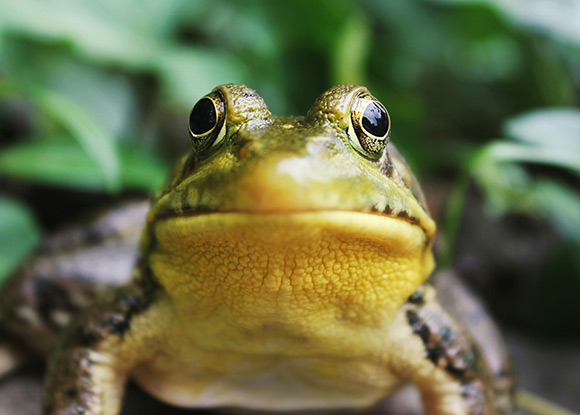
A frog in a pond. Photo: Jack Hamilton/Unsplash
Iowa’s Department of Natural Resources (IDNR) will be hosting four frog and toad call survey training workshops in 2024, two in person and two online via Zoom. These workshops are for anybody interested in getting involved in Iowa's Frog and Toad Call Survey. The Survey has been collecting data on the state's amphibians for more than 30 years. It began in 1991, when a group of dedicated community scientists learned frog and toad calls and trooped out into the night to visit wetlands across the state. Over the years, volunteers have collected data on over 2,200 wetlands and provided an incredible record of frog and toad activity. Interested volunteers should first visit https://www.iowadnr.gov/vwmp and read through the survey requirements. You can then see whether there are any survey routes nearby that need a monitor by browsing maps of available routes. Surveyors are especially need in western and southern Iowa, home to a larger number of different frog species. Don't see an available route? Create your own. The time commitment to do the survey and submit data is about 10 total hours between April and July. This will require being out after dark for roughly two hours during each survey period. Workshops are most appropriate for adults and children older than 12. The Zoom workshops will be held Monday, March 11, 6:30 - 9:30 p.m.; and Saturday, March 16, from 1 - 4 p.m. The in-person workshops will be held Wednesday, April 3, from 6:30 - 9:30 p.m., at Montgomery County’s Wolfe Nature Center; and on Wednesday, April 10, from 6:30 - 9:30 p.m., at Mitchell County’s Milton R. Owen Nature Center. Prospective surveyors must attend one of the four scheduled workshops, and there is a $10 fee to cover workshop materials. To learn more about the survey visit the DNR Volunteer Wildlife Monitoring Program webpage, or contact Stephanie Shepherd at vwmp@dnr.iowa.gov.
Wisconsin Seeks Volunteer Campground Hosts
.jpg)
Wisconsin wants volunteer campground hosts Photo: Tegan Mierle/Unsplash
The Wisconsin Department of Natural Resources (DNR) is seeking volunteers who like spending time outside, helping other outdoor enthusiasts and are passionate about Wisconsin’s natural resources to serve as volunteer campground hosts. Volunteer opportunities are available at DNR properties in all parts of the state. Host responsibilities generally include:
• Staying at a campsite at the campground and volunteering for a few hours each day.
• Greeting campers and answering questions about the property.
• Helping with daily campground operations and setting an example by being a model camper.
• Cleaning campsites, bathrooms and facilities and helping out with light maintenance.
• Sharing park information and helping with campground programs.
• Enjoying the company of other campers and ensuring they enjoy their stay.
• Volunteers are an integral part of the programming, operations and management services of Wisconsin’s state parks, forests, recreation areas and trails.
In addition to general campground hosts, the DNR seeks volunteer equestrian campground hosts at Governor Knowles State Forest, Kettle Moraine State Forest – Northern and Southern Units and Wildcat Mountain State Park. Openings for equestrian campground host opportunities are available from May through November, with dates varying by property. Stay at a campsite at the horse campground and volunteer a few hours per day. A 1 to 2-month service period is preferred. Apply to be a campground host through WDNR’s online volunteer opportunities webpage, https://dnr.wisconsin.gov/topic/parks/volunteer.
Urban Fishing Program Seeks Instructors

IDNR seeks instructors for its Urban fishing Program. Photo: Kelly Sikkema/Unsplash
The Illinois Department of Natural Resources (IDNR) is accepting applications for instructors for 2024 summer fishing clinics through the department’s Urban Fishing Program. Fishing instructors are the department’s boots on the ground at free clinics hosted in communities throughout Illinois. These are temporary positions not to exceed six months, making them perfect for teachers, retirees, students and others eager to help people learn about fishing skills and ecology. The Illinois Urban Fishing Program was established in 1985 to teach people of all ages to fish, to provide better local fishing opportunities, and to offer participants an understanding of and a greater appreciation for natural resources. Available spots are based in Boone, Champaign, Jackson, Jefferson, Macon, Madison, McLean, Peoria, Rock Island, Sangamon, and St. Clair counties. Numerous spots are also available for Chicago, Cook County, and the northeastern part of Illinois. To learn more visit https://bit.ly/IDNRjobs. Look for positions titled “conservation education representative.”
Wisconsin Issues Updated Safe Fish Consumption Guidelines
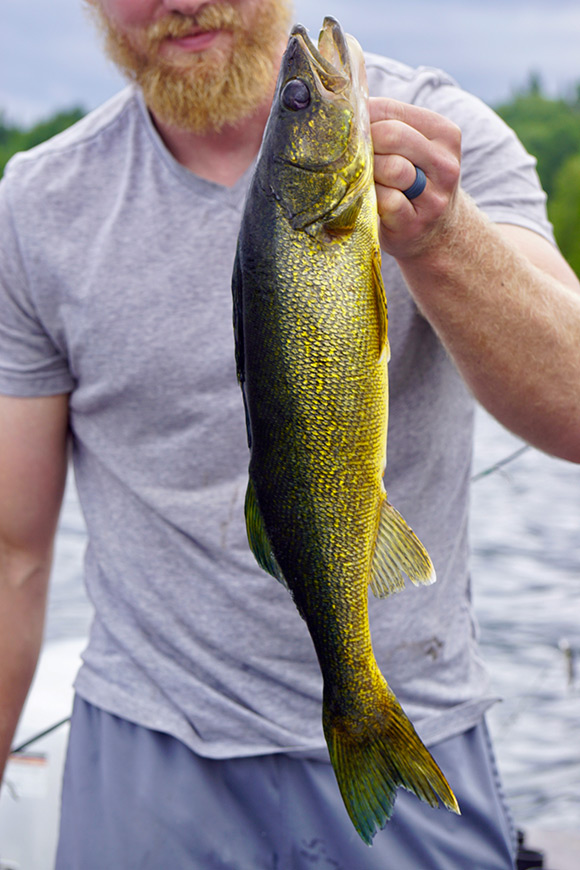
Fish are full of important nutrients and are a great source of lean protein, however, they may also
contain pollutants that can harm humans. Photo: Zab Consulting/Unsplash
Wisconsin’s Department of Health Services (DHS) and the Wisconsin Department of Natural Resources (DNR) have issued the 2024-2026 “Choose Wisely booklet,” which outlines guidelines for safe fish consumption. Fish are full of important nutrients like omega-3s and are a great source of lean protein, however, they may also contain pollutants from their environment and the food they consume that can cause health risks for humans. To address this, DNR fisheries staff routinely sample fish from areas with suspected pollution or contamination as well as from heavily fished areas. Based on the levels of contaminants found, like polychlorinated biphenyls (PCBs), mercury and perfluorooctane sulfonate (PFOS), experts can determine the amount of fish that is safe to consume over a person's lifetime to avoid negative health impacts. The updated version of the Choose Wisely booklet identifies new advisories for Wisconsin waterbodies that have either elevated or decreased levels of contaminants. DNR encourages the public to follow the safe-eating guidelines to reduce the risk of exposure to unwanted contaminants. For more information, including specific waterways guidelines, visit the online version of Choose Wisely at https://widnr.widen.net/s/s6mkcq6tmr/pub_fh_824_choosewisely.
Report Furbearer Sightings
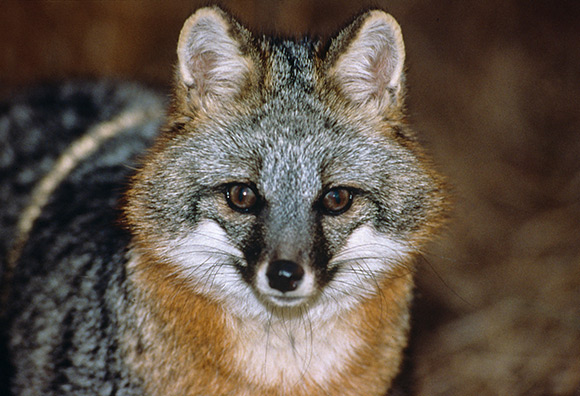
A gray fox. Photo: ODNR
The Ohio Department of Natural Resources (ODNR) Division of Wildlife is seeking reports of gray foxes, river otters, black bears and other furbearers. Reports can be submitted to the Wildlife Reporting System at wildohio.gov and on the HuntFish OH mobile app. Wildlife biologists use public reports to monitor populations of these secretive species. For example, the gray fox is one of two fox species found in Ohio, although it is less common than the red fox. Gray foxes prefer wooded areas and thick brush, whereas red foxes use a mix of habitats, including agricultural areas and woods. The gray fox has a unique ability among canines to climb trees. The species is most abundant in the forested portions of eastern Ohio. Its nocturnal and secretive habits make the gray fox difficult to track. Submitting photos or sightings, as well as carcasses, to the Division of Wildlife will help guide gray fox management and provide biologists with information on population health, demographics, and genetics. Also, black bears are endangered in Ohio and were once extirpated. The species began naturally recolonizing eastern Ohio at the end of the last century, and while sightings are still relatively uncommon, they have been increasing in recent years. Report sightings and, when possible and safe, photos of black bears to the Division of Wildlife. Contact your county wildlife officer to submit river otter and gray fox carcasses. Submitted carcasses can be from harvests or roadkill, although it is not permitted to collect roadkill carcasses. One can report the location of roadkill to their local wildlife officer. Other furbearers that citizen scientists can report include fishers, badgers, weasels, and bobcats. Visit wildohio.gov to find out more.
More ATV/UTVs On the Roads
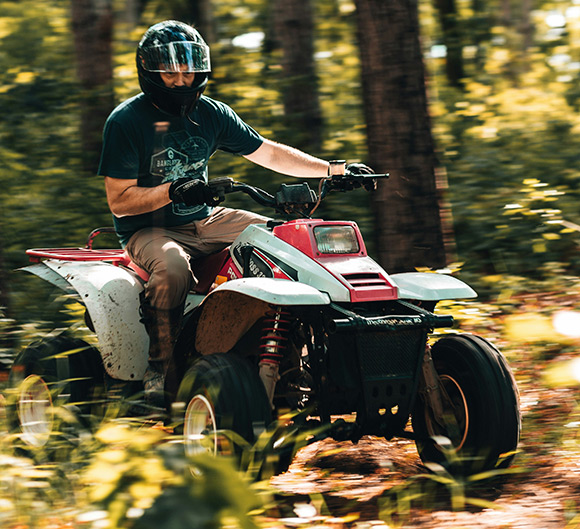
An ATV rider travels a trial. Photo: Joshua Hanson/Unsplash
The Wisconsin Department of Natural Resources (DNR) is urging users of all recreational vehicles to be mindful of safety in this year’s changing conditions when operating throughout the state. With climbing temperatures across the state, many of Wisconsin’s trails are again being used by ATV/UTV riders. However, a lack of snow doesn’t necessarily mean trails are safe. Changing conditions, including rain, snow melt and freezing fog, make surfaces slippery – especially roadways. Off-road vehicles may have excellent traction on dirt tracks and overland trails, but that isn’t the case on wet or frozen winter roads. There has already been one fatal ATV/UTV crash and two snowmobile crashes that resulted in three fatalities in the state in 2024. Drive slow, sober and wear a helmet to help protect yourself and others on Wisconsin’s trails. The consumption of alcohol or drugs, excess speed and operator error are all leading causes of fatal crashes.
Aa few more safety tips to keep in mind when operating your off-highway vehicles during winter:
• Always wear a seatbelt in a UTV.
• Let someone not riding with you know where you are going and when you will return.
• Follow all posted speed limits and regulatory signs.
• Double-check before operating on trails. Many trails open to ATVs/UTVS are closed during winter in anticipation of snowmobile season.
Wisconsin law requires ATV and UTV operators born on or after Jan. 1, 1988, who are at least 12 years old for an ATV (and at least 16 years old for UTV) to complete an ATV safety certification course to operate. These safety courses can be taken online or in person. A list of approved safety education classes is available on the DNR Safety Education webpage. Wisconsin law also requires every operator involved in a crash incident to report the incident to law enforcement officials without delay. Operators must submit a written report to the DNR within 10 days of the incident. For more information visit WDNR’s ATV/UTV webpage, dnr.wisconsin.gov/topic/atv.
Fall Turkey Bag Tops 980
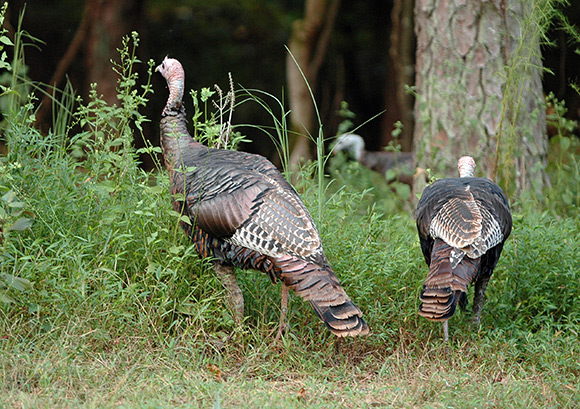
West Virginia hunters tagged 981 fall turkeys in 2023 Photo: WVDNR
The West Virginia Division of Natural Resources (WVDNR) reported that fall turkey hunters harvested 981 wild turkeys during the 2023 fall season. Due to lower brood production, the 2023 harvest saw a 3% decrease over 2022’s harvest of 1,012 birds. However, the fall season was 1% above the five-year average and 12% below the 10-year average. Fall turkey harvest numbers are influenced by hunter participation but also depend on the current year’s brood production and mast conditions. Brood production in 2023 was lower than last year. However, more counties were open for a two-week fall season due to a higher spring gobbler harvest than last year. Districts one and four increased their harvest over 2022, with the others showing a slight decline. District four had the highest harvest (229 birds), followed by District three (215), District one (165), District two (142), District six (119) and District five (111). Counties with the most harvests were Nicholas County (57 birds), Greenbrier (46), Monroe (43), Randolph (42) and Fayette (32). These counties, except Fayette, had a four-week season.
Surveillance detects 31 positive CWD cases
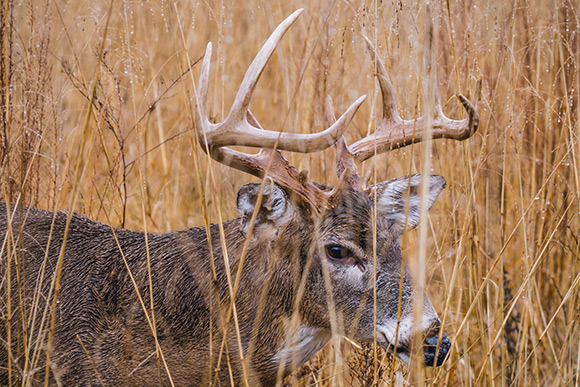
Nebraska detected 31 new CWD cases in 2023. Photo: Anthony Roberts/Unsplash
Chronic wasting disease surveillance conducted in central and north-central Nebraska during the November firearm deer season detected 31 positive cases in deer. More than 600 samples were collected from harvested deer at check stations in the Sandhills, Keya Paha, Calamus East, Calamus West and Loup West Deer Management Units. CWD was detected for the first time in Rock, Blaine and Thomas counties.CWD surveillance in Nebraska takes place in five to seven units each year, rotating to a different part of the state each year. Currently, there is no strong evidence CWD poses a risk for humans; however, public health officials recommend that human exposure to CWD be avoided. People should remain cautious in how they handle, process and consume deer. Hunters and commercial processors should avoid butchering or processing deer that spreads spinal cord or brain tissue to meat or to the environment. CWD is a prion disease that attacks the brain of infected deer, elk and moose. Animals in the late stages of CWD often are emaciated, show erratic behavior and exhibit neurological irregularities. However, due to the slow advancement of the disease, infected deer may not show symptoms for many years. CWD always is fatal. CWD was first discovered in Colorado in 1967 and in Nebraska in 2000 in Kimball County. Since 1997, the Nebraska Game and Parks Commission has tested more than 57,000 deer and more than 400 elk. Of these, 1,269 deer and 19 elk have tested positive for CWD, and CWD has been detected in free-ranging deer and elk in 57 counties. No population declines have been attributed to the disease. To view the 2023 testing results, visit OutdoorNebraska.gov and search for CWD.
MDC Changes Spring Turkey Regulations
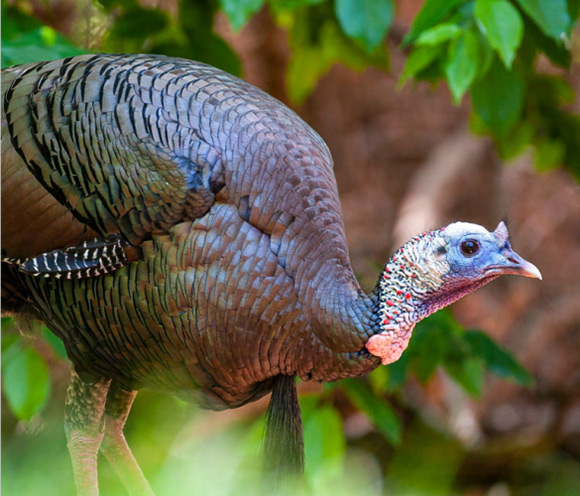
A spring gobbler moves through the woods. Photo: MDC
The Missouri Department of Conservation (MDC) has changed turkey hunting regulations for the spring season. The state Conservation Commission approved the changes for the spring season in December and gave initial approval to proposed fall turkey regulation changes. Spring shooting hours for private land only will be extended from a half-hour before sunrise to sunset. Shooting hours on public land will remain a half-hour before sunrise to 1 p.m. These changes will be effective for the Spring 2024 turkey season. Proposed changes to fall turkey hunting would require both fall firearms turkey hunters and fall archery turkey hunters to purchase a fall turkey-hunting permit. Turkeys would no longer be included in the archery-deer permit. The bag limit would be reduced from four to two birds. These proposed fall changes will be open for public comment from through March 2, under Public Commenting Opportunities at mdc.mo.gov/contact-engage/public-commenting-opportunities. According to MDC, the primary motivation for the regulation changes is to increase opportunities during the spring season for youth hunters and hunters who work during the day and to reduce the fall harvest while maintaining as much opportunity for hunters as possible. MDC noted that 93% of land in Missouri is privately owned and 88% of Missouri’s annual spring turkey harvest is done on private land. MDC added that maintaining shooting hours ending at 1 p.m. on conservation areas and other public lands would continue to support multiple afternoon activities by a variety of users on these areas. Learn more about turkey hunting in Missouri at mdc.mo.gov/hunting-trapping/species/turkey.
Upcoming Events
North Orwell Pennsylvania Sportsmen’s Show - The North Orwell Pennsylvania Sportsmen’s Show will be held May 10, 7 am – dark and May 11, 7 am - noon. Admission is free. For more information, contact Bruce (607) 426-6276.
What’s Coming in April
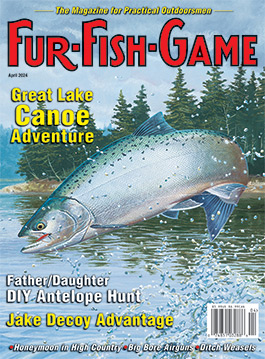
Lake Superior Canoe Adventure - Geoff Coleman shares how a senior high school fishing trip on the big lake cemented lifelong friendships between teacher and students and was reenacted 30 years later.
Jake Decoys for Spring and Fall - Phil Goes learns that jake decoys have their place in turkey hunting spring or fall.
Wyoming Antelope Hunt - Susanna Kailing tells how she and her father, Michigan residents, embarked on a DIY antelope hunt in Wyoming and discovered it can be done with some planning.
The Family Turkey Hunt - Dwight Yoder explores how his father started his turkey obsession and how he has passed this along to his children.
Get More from Your Big Bore Air Gun - Jeff Wolgast tells you how to make your big bore air gun more effective and efficient.
Other Stories
• The Gift Bear - Chris Matishak tells how an unscripted spring bear hunt turned into a lifetime memory.
• Deep Cover Bodygrips - Brandon Mitchell how invisible that trap could be. Since then, I’ve used that as my system’s guide to make my bodygrips as effective and invisible as possible.
• Reading Water – Jeff Walters gives anglers a primer on how to read fish-holding waters.
• Lew & Charlie, Chapter VI, Part 2
• Ashes to Ashes, Dust to Dust – Bruce Ingram considers ash trees, how they were important to his deer hunting, and how they’ve disappeared from his area thanks to the emerald ash borer.
• Tin Can Bullets – Jeff Wolgast share how to make your own bullets over an open fire.
• The Wily Red – Tom Edgington remembers the highs and lows of collecting red fox urine from a fox he caught as a kid and kept in the backyard for a time.
• Weasels In the Ditch – John Murray shares how to catch weasels in ditches.
• Honeymoon In High Country – Lucas Byker tells how he and his wife Allison shared their honeymoon in Alaska’s high country chasing ptarmigan and catching fish.
• My First Mink- Mark D. Imel shares the story of the first mink he caught as a boy trapper in 1970.
• Cold Calls and Clouser Minnows – B.B. Sanders relates his path to sales success and learning how to tie the Clouser Minnow fly pattern.
End of the Line Photo of the Month
Sophia Brontrager, Sam Hall, Darrin Brontrager, Kenneth Hall, Kenneth Brontrager - Indiana
SUBSCRIBE TO FUR-FISH-GAME Magazine

